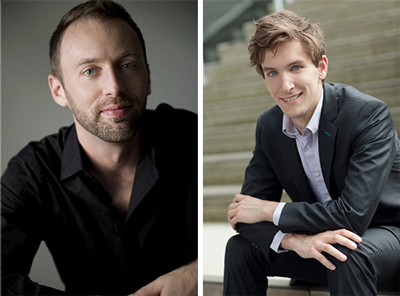by Mike Telin

This weekend, Les Délices will prove that two harpsichords are better than one when Michael Sponseller and Jacob Street combine their musical wizardry for two concerts entitled “The Imaginary Orchestra.”
The program, presented on Saturday, January 16 at 8:00 pm in The Galleries at Cleveland State University and on Sunday at 4:00 pm at Herr Chapel in Plymouth Church in Shaker Heights, will feature arrangements from operas by Jean-Baptiste Lully, Marin Marais, Jean-Philippe Rameau, and Pancrace Royer, as well as the rarely heard symphony for two harpsichords by Armand-Louis Couperin. Les Délices artistic director Debra Nagy and harpsichordist Lisa Goode Crawford will present a pre-concert talk at each performance.
In their program notes, Nagy and Crawford point out that “opera is one of the defining forms of the Baroque period…everyone at the court and in the French aristocracy went to these operas, and just as with Broadway musicals, the audience hummed the most tuneful or otherwise memorable bits and wanted to reproduce them at home.”
Music publishers were more than happy to oblige and began printing reduced scores of the operas that amateur musicians could perform at home on their own keyboards. It is these reductions that served as the source material for Sponseller’s and Street’s program. “The published scores that were left for us are often in what we call ‘short score,’” Sponseller said. “Everything you need to know to play the pieces is there, although some things such as the viola parts are often left out. At that time, these ‘short scores’ provided a way for people to be able to play the piece at home in whatever form they could — whether that be with one, two, four, or six people.”
The performers agree that one harpsichord is certainly capable of making magic, but two instruments are even better. Street said that filling in those “missing” parts requires some improvisation. “Many times one of us will be playing what is written in the score — the melody and bass line — and the other person will fill in the viola line to make it sound more interesting. Because we’re both working from skeleton scores and choosing which parts we should cover at any given time, the most important thing is to support each other, but also to stay out of each other’s way. You don’t want to be doubling what the other is doing, like trilling on the same note.”
During the concerts, Michael Sponseller and Jacob Street will be performing on two instruments belonging to Lisa Goode Crawford, both of which are regularly used by Les Délices. Both are replicates of Flemish-style instruments that were later enlarged by French builders to increase their keyboard range.
“The ‘earlier’ instrument, which was made by Earl Russell about fifteen years ago, is based on a Ruckers,” Sponseller explained. “It has a Flemish body, but it’s really a French instrument — it’s kind of a hybrid. It produces what was the desired sound in France circa 1700. The second instrument, which was made by the Canadian builder Edward Turner after a harpsichord by the Goermans (or Germain) family, is a larger example of the Russell. Again, it’s a Flemish idea which was turned into a French instrument.
“In some ways the two are very similar. Their ranges are almost identical and tonally they are of the same mind. They both have big, powerful sounds.”
With nearly 500 keyboard arrangements of excerpts from Lully operas alone to choose from, Sponseller said that the task of choosing music for a 50-minute program was difficult. “I was going crazy just because there are so many wonderful pieces. I wasn’t trying to choose only exotic or rare pieces. I wanted a mix of familiar repertoire along with unfamiliar works by composers people know. That’s why there is a concentration of Lully and Rameau on the program.”
The program will include such rarities such as the “Air” and “Sarabande” from Marin Marais’ opera Alcide (1693), which have never been performed in Ohio. “Exotic” is how Sponseller described Pancrace Royer’s “Les Craintes, Les Pleurs” from Le Pouvoir de l’Amour (1743). “Lisa Crawford has been a champion of his repertoire for 30 years. I wanted to include it in honor of her. It’s wonderful music that still flies under most people’s radar.”
Another rarely heard work included on the program is Rameau’s “Trio des Parques” from Hippolyte et Aricie (1733), which Sponseller described as that composer’s Rite of Spring. “When this piece was first being rehearsed, it was so strange harmonically that the orchestra refused to play it, so it was cut and never performed during any of the opera’s revisions. On paper it appears simplistic, but it breaks all of the rules of that time. It’s originally written for three male singers and full orchestra. In our version we’re combining the avant-garde and the traditional, which will hopefully capture the best of both sides of Rameau.”
But of all of these pieces, the true oddity of the program will be the Simphonie de deux Clavecins in D (1773) by Armand-Louis Couperin , the great-nephew of the composer and keyboardist François Couperin. Although Armand-Louis was a renowned improviser and teacher, Sponseller noted that “in the history books he is mainly known for one thing, and that’s having died tragically — killed by a horse while rushing between church services.”
Street pointed out that the program also includes many familiar works that will be heard in a new context. “There are many pieces with orchestrations that translate well for two harpsichords and show the possibilities of the repertoire. I think they will make people turn their heads, and I’m excited for that.”
Street went on to say that the concerts present audiences the rare opportunity to hear a duo harpsichord recital. “Most people aren’t used to seeing even one harpsichord in a room, let alone two. It’s a unique thing. I think because the whole concert is an improvisatory conversation between the two of us, the two concerts should sound pretty different from one another — in a good way.”

Published on ClevelandClassical.com January 12, 2016.
Click here for a printable copy of this article



